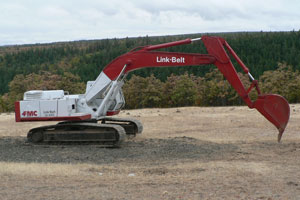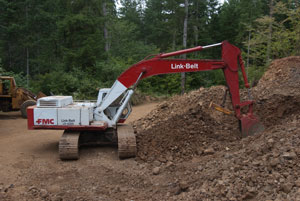



|

|

|
Link-Belt is an old and respected name for shovels and cranes in the US. I'm of the impression that Link-Belt still makes some hydra cranes, but what became known as the 'excavator' replaced the mechanical shovels, and in the market shake out of 1980, Asian manufacturers came to dominate the US excavator market. The Link Belt excavator is no exception. It is a Sumimoto excavator with a Link-belt paint job. The essentially identical machine is also marketed in the US under the Case label with different paint.
The product you see here is a mid 1980's version of the LS-4300. It's similarity to the Link-Belt 4300 log loaders featured on the log loader section of this web site is only superficial. They are of the C2 series which is a newer generation. Other than the tracks this machine and the newer C2 series have very little in common. Though both have Izuzu Diesel engines they are different models and even installed in the excavator other end to. The newer machines are heavier as well as being more powerful. This machine is thought to weigh just over 30 tons.
Once you get one of these machines, you fairly quickly figure out that unless it is only going to dig ditches for a living, you need to make it more versatile. Just as the human hand is vastly more successful because it has a thumb, so is the excavator. With a thumb, an excavator can grasp things irrespective of whether they will fit in the bucket or not.
On some jobs encountering things that won't fit in the bucket is not an issue, but if you use an excavator around where trees grow, or where there are big rocks, the ability to grasp thing is mission critical. As a result thumbs are common additions to excavators of all sizes. Some are 'home additions' while others are made by major manufacturers. They are not all the same. The most common difference has to do with whether they are hydraulic or not.
Thumbs are commonly hinged near the bucket pivot. Some in fact pivot on the same pin as the bucket. The Hydraulic part has to do with whether the pivoting is controlled by a hydraulic cylinder or a simple manual locking system. The best and most useful thumbs are hydraulic, but they are also more expensive in that you have to break into the hydraulic system and add another spool, and related equipment, which in a high pressure system such as this link belt has, requires some serious hydraulic engineering, and significant expense.
A rube with a welder can make a mechanical thumb. The one we chose to make is made entirely out of scrap iron and pieces of iron found in the 'berry patch' out behind the shop.
Our cost here was some scrap iron we didn't sell, and quite a bit of welding, but what we got is a device that will make it much easier to handle stumps and other oversize objects.